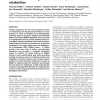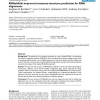281 search results - page 12 / 57 » Functional annotation of proteomic sequences based on consen... |
NAR
2008
13 years 7 months ago
2008
Protein sequences are the most important source of evolutionary and functional information for new proteins. In order to facilitate the computationally intensive tasks of sequence...
BMCBI
2008
13 years 7 months ago
2008
Background: The prediction of a consensus structure for a set of related RNAs is an important first step for subsequent analyses. RNAalifold, which computes the minimum energy str...
BMCBI
2004
13 years 7 months ago
2004
Background: RNA secondary structure prediction methods based on probabilistic modeling can be developed using stochastic context-free grammars (SCFGs). Such methods can readily co...
BMCBI
2005
13 years 7 months ago
2005
Background: Beta-barrel transmembrane (bbtm) proteins are a functionally important and diverse group of proteins expressed in the outer membranes of bacteria (both gram negative a...
BMCBI
2002
13 years 7 months ago
2002
Background: Total sequence decomposition, using the web-based MASIA tool, identifies areas of conservation in aligned protein sequences. By structurally annotating these motifs, t...


